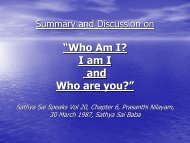Gyani Baile & Dolly Baile
Gyani Baile & Dolly Baile
Gyani Baile & Dolly Baile
Create successful ePaper yourself
Turn your PDF publications into a flip-book with our unique Google optimized e-Paper software.
is realized through mental or spiritual discipline of yoga. Sage Vyasa<br />
arranged the Vedas in four books namely 1) Rig Veda: a book of chants<br />
2) Yajur Veda : in addition to verses from Rig Veda it contains original<br />
sacrificial prayers, 3) Sama Veda: consists mostly of stanzas from the<br />
Rig Veda. The arrangement of its verse is with reference to their place<br />
and use in the Soma sacrifice. 4) Atharva Veda: it deals with spells,<br />
incantations, kingly duties, exalted spiritual truths. It consists of special<br />
class of Vedic texts known as chhandas.<br />
The contents of Vedas fall into two general divisions 1)<br />
Karmakanda: Deals with karma, ritualistic action, sacrifices etc. the<br />
purpose of which is the attainment of material prosperity, 2)<br />
Jnanakanda: deals with knowledge through which one is liberated from<br />
ignorance and enabled to realize the Highest God.<br />
Each of the Vedas fall into two sections 1) Mantra (also called<br />
Samhita): a collection of hymns and prayers used in sacrifice. 2)<br />
Brahmana: contains rules and regulations of the sacrifices and reveals<br />
the meaning of the Mantras.<br />
The most important part of the Vedas is the knowledge revealed in the<br />
Upanishads (it is said that Upanishads reveal some of the most profound<br />
spiritual truths ever known to mankind). There are 108 or more<br />
Upanishads in all. Among these 12 are most popular - Isa, Kena, Katha,<br />
Prasna, Mundaka, Mandukya, Aietareya, Taittiriya, Chandogya,<br />
Brihadaranyaka, Kaushitaki and Svetasvatara.<br />
The next set of books are the secondary Vedas called Upa Vedas,<br />
these are also four in number 1) Ayurveda: The science of extending life,<br />
2) Dhanurveda: The science of archery and the use of weapons, 3)<br />
Gandharva Veda: the science of music and dance. 4) Arthashastra:<br />
This is treatise on politics, state administration and the conduct of<br />
commerce.<br />
There are six explanatory limbs of the Vedas called Vedangas : 1)<br />
Sikshah: Science of phonetics and pronunciation, 2) Vyakarana: the<br />
science of grammar, 3) Nirukta: the science of etymology of the words in<br />
the Vedic mantras, 4) Chandas Shastra: the art of versification, 5) Kalpa<br />
129



